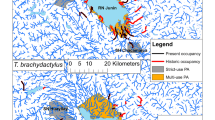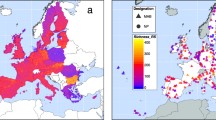Abstract
Legal instruments for species conservation have been criticised because they take a long time to draw up and implement and because invertebrates are highly underrepresented. For these reasons legal documents need regular re-evaluation as more data and effective methods are available. The effectiveness of the Hungarian legislative texts was assessed by the congruence between protection status and conservation priority of the species. Species were prioritised according to the conservation priority index (CPI = MRI × PBR), which included mollusca rarity index (MRI) and protection-by-reserves score (PBR). Mollusca rarity index was an additive scoring method including global range size, local frequency, and a correction factor due to the biased frequency estimate or special importance of some species. PBR scores expressed the lack of congruence between distribution of reserves and distribution of species. I used the distribution data of 121 Hungarian land snail species based on 10 × 10 km resolution grid system. Current protection status of the species was associated with rarity, whereas the congruence between species occurrences and the location of existing reserves has been overlooked. Based on the 25% of the species with highest CPI scores, the species Helicigona planospira was highly recommended and 9 other species was recommended for protection. Two thirds of the occurrences of the strictly protected and endemic species Hygromia kovacsi and more than 25% of the occurrences of 10 protected species were located outside of current reserves. Local populations of these species need monitoring in order to detect changes in the area of occupancy.
Similar content being viewed by others
References
Araújo M.B. (2004). Matching species with reserves -uncertainties from using data at different resolution. Biol. Conserv. 118: 533–538
Bakó B. and Korsós Z. (1999). UTM mapping and potentials of the Hungarian herpetofauna. Állattani Közlemények 84: 43–52 (in Hungarian with English abstract)
Báldi A. and Csorba G. (1997). Ecological validation to the legal status of terrestrial vertebrates in Hungary. Természetvédelmi Közlemények 5–6: 79–86(in Hungarian with English abstract)
Báldi A., Csorba G. and Korsós Z. (2001). Setting priorities for the conservation of terrestrial vertebrates in Hungary. Biodivers. Conserv. 10: 1283–1296
Borhidi A. (1995). Social behaviour types, the naturalness and relative ecological indicator values of the higher plants int he Hungarian flora. Acta Bot. Hung. 39: 97–181
Bouchet P., Falkner G. and Seddon M.B. (1999). Lists of protected land and freshwater molluscs in the Bern Convention and European Habitats Directive: are they relevant to conservation?. Biol. Conserv. 90: 21–31
Cameron R.A.D. (1998). Dilemmas of rarity: biogeographical insights and conservation priorities for land mollusca. J. Conchol. Special Publicat. 2: 51–60
Cameron R.A.D. and Pokryszko B. (2005). Estimating the species richness and composition of land mollusc communities: problems, consequences and practical advice. J. Conchol. 38: 529–547
Council of Europe 1979. Convention on the Conservation of European Wildlife and Natural Habitats. Bern.
Council of Europe 1992. Council Directive 92/43/EEC on the Conservation of Natural Habitats and of Wild Fauna and Flora. Brussels.
Dévai G. and Miskolczi M. (1987). Proposal for a new method of environmental quality evaluation on the basis of grid maps of distribution data of dragonflies. Acta Biol. Debrecina 19: 33–54(in Hungarian with English abstract)
Dobson A.P., Rodriguez J.P., Roberts W.M. and Wilcove D.S. (1997). Geographic distribution of endangered species in the United States. Science 275: 550–553
Ehrmann P. (1956). Mollusca. Verlag von Quelle & Meyer, Leipzig (in German).
Fehér Z. and Gubányi A. (2001). The Distribution of Hungarian Molluscs. The Catalogue of the Mollusca Collection of the Hungarian Natural History Museum. Hungarian Natural History Museum, Budapest
Fehér Z., Majoros G. and Varga A. (2006). A scoring method for the assessment of rarity and conservation value of the aquatic molluscs in Hungary. Heldia 6: 101–114
Gaston K.J. (1994). Rarity. Chapman and Hall, London
Hartley S. and Kunin W.E. (2003). Scale dependency of rarity, extinction risk and conservation priority. Conserv. Biol. 17: 1559–1570
Heller J. and Safriel U.N. (1995). Setting priorities for the conservation of land snail faunas. In: Bruggen, A.C. and Kemperman, T.C.M. (eds) Biodiversity and Conservation of the Mollusca, pp 91–110. Backhuys Publisher, Oegstgeest-Leiden
Horváth F., Dobolyi Z.K., Morschauser T., Lökös L., Karas L. and Szerdahelyi T. 1995. Flóra adatbázis 1.2. MTA ÖBKI 367, Vácrátót (in Hungarian).
Hungarian Ministry of Environment 2001. Order No. 13/2001. (V. 9.) on the strictly protected and protected flora and fauna species and on strictly protected caves. Budapest.
Hunter M.L. (1996). Fundamentals of Conservation Biology. Blackwell, Cambridge, USA
Jaeckel S.G., Meise W. and Klemm W. (1957). Die Land- und Süsswasser-Mollusken der Nördlichen Balkanhalbinsel. Abhandlungen und Berichte aus dem staatliches Museum für Tierkunde, Forschungsstelle, Dresden 23: 141–205 (in German).
Kerney M.P., Cameron R.A.D. and Jungbluth J.H. (1983). Die Landschnecken Nord- und Mitteleuropas. P. Parey, Hamburg-Berlin (in German).
Mace G.M. and Kershaw M. (1997). Extinction risk and rarity on an ecological timescale. In: Kunin, W.E. and Gaston, K.J. (eds) The Biology of Rarity: Causes and Consequences of Rare-common Differences, pp 130–149. Chapman and Hall, London
Medvegy M. (2001). Endangerness of the Hungarian longhorn beetles (Cerambycidae, Coleoptera). Természetvédelmi Közlemények 9: 163–199 (in Hungarian with English abstract).
Myers N., Mittermeier R.A., Mittermeier C.G., Fonseca G.A.B.d. and Kent J. (2000). Biodiversity hotspots for conservation priorities. Nature 403: 853–858
Pál-Fám F., Benedek L. and Rimóczi I. (2004). Conservation of macrofungi in Hungary: possibilities and perspectives. Természetvédelmi Közlemények 11: 163–173 (in Hungarian with English abstract)
Patten M.A. and Erickson R.A. (2001). Conservation value and rankings of exotic species. Conserv. Biol. 15: 817–818
Pintér L. (1984). A revised catalogue of the recent molluscs of Hungary. Folia Historico-naturalia Musei Matraensis 9: 79–90 (in Hungarian).
Pintér L., Richnovszky A. and Szigethy A. (1979). Distribution of the recent Mollusca of Hungary. Soosiana Suppl. 1: 1–351
Pintér L. and Szigethy A.S. (1979). Die Verbereitung der rezenten Mollusken Ungarns: Neunachweise und Berichtigungen, I. Soosiana 7: 97–108
Pintér L. and Szigethy A.S. (1980). Die Verbereitung der rezenten Mollusken Ungarns: Neunachweise und Berichtigungen, II. Soosiana 8: 65–80
Pokryszko B.M. (2003). Vertigo of continental Europe – autecology, threats and conservation status (Gastropda, Pulmonata: Vertiginidae). Heldia 5: 13–25
Pusanow J. (1928). Die malacogeographische Gliederung der Krim und der Ursprung ihrer Molluskenfauna. Zoologische Jarbücher, Abteilung für Systematik, Ökologie und Geographie der Tiere 54: 315–342 (in German)
Rácz I.A. (1998). Biogeographical survey of the Orthoptera fauna in central part of the Carpathian Basin (Hungary): fauna types and community types. Articulata 13: 53–69
Rakonczay Z. (ed.), (1989). Red Data Book. Academic Press, Budapest (in Hungarian with English abstract)
Sárospataki M., Novák J. and Molnár V. (2003). Mapping of the distribution of the bumble bee species (Hymenoptera: Apidae, Bombus and Psithyrus spp.) in Hungary, and its possible application in nature conservation. Állattani Közlemények 88: 85–10 (in Hungarian with English abstract).
Simon T. (1992). A magyarországi edényes flóra határozója. Nemzeti Tankönyvkiadó, Budapest
Sólymos P. (2004). The assessment of the Hungarian land molluscs based on their rarity and its applications. Természetvédelmi Közlemények 11: 511–520 (in Hungarian with English abstract)
Soós L. (1943). The Mollusc Fauna of the Carpathian Basin. Academic Press, Budapest (in Hungarian).
Wiktor A. and Szigethy A.S. (1983). The distribution of slugs in Hungary (Gastropoda: Pulmonata). Soosiana 10/11: 87–111
World Conservation Union (IUCN) 2004. Guidelines for using the IUCN Red List categories and criteria. http://iucn.org/themes/ssc/red-lists.htm. Accessed: 9.6.2004.
World Conservation Union (IUCN) 2005. IUCN Red List of threatened species. http://www.redlist.org. Accessed: 15. 07. 2005.
Author information
Authors and Affiliations
Corresponding author
Rights and permissions
About this article
Cite this article
Sólymos, P. Are current protections of land snails in Hungary relevant to conservation?. Biodivers Conserv 16, 347–356 (2007). https://doi.org/10.1007/s10531-005-2354-3
Received:
Accepted:
Published:
Issue Date:
DOI: https://doi.org/10.1007/s10531-005-2354-3




